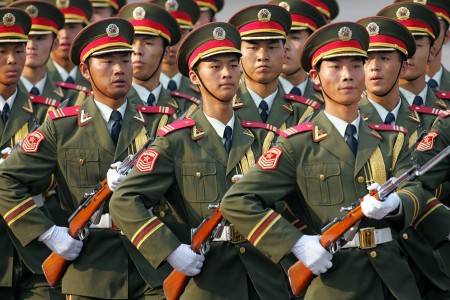Palace Intrigue: Chinese Soldiers Storm Replica of Taiwan Presidential Office
Jul 23, 2015

Is Beijing doubling down on its longstanding threat to reclaim Taiwan by force? That’s a concern for some Taiwanese after China’s state broadcaster showcased a recent military drill that featured soldiers storming an apparent replica of the island’s presidential palace.
Officials in Taipei have denounced the drill as harmful to the rapprochement of recent years between Taiwan and China, after decades of hostility following a civil war in the middle of the last century. Political and military experts, meanwhile, say the apparent targeting of an important political symbol for Taiwan marks Beijing’s latest bid to sway Taiwanese voters ahead of a key presidential poll next January.
The newsreel in question, first aired by China Central Television on July 5, featured dramatic footage of an annual military exercise in northern China—spanning fiery artillery barrages, imposing armored columns and infantry assaults on a mock-up city. The video went largely unnoticed until Wednesday, when a Shanghai-based media outlet said it demonstrated how Beijing “would use force to solve the Taiwan issue.”
The CCTV report swiftly struck a nerve in Taiwan, where President Ma Ying-jeou’s engagement policies with China have proved divisive, compounding the declining public support his ruling Nationalist Party is experiencing over economic and social fairness issues. Many commentators on Taiwanese media directed their ire on segments from the newsreel that appeared to show Chinese troops advancing toward a red-and-white structure that closely resembled Taiwan’s Presidential Office—built in a distinctive European-style in the 1910s by Japanese colonial administrators.
The implied assault on Taipei was “unacceptable for the Taiwanese public and the international community,” Major Gen. David Lo, spokesman for Taiwan’s Ministry of National Defense, told local media Wednesday. “The Chinese Communist Party hasn’t given up on armed assault on Taiwan, and their military preparations are still geared toward the use of force against Taiwan,” he said.
China’s defense ministry denied that Taiwan was the object of the drill. “This is a routine annual military exercise, and isn’t directed at any particular target,” it said in a terse statement in response to queries from China Real Time on Thursday.
The exercise was the latest in a series of military drills that kicked off last month at a training base in China’s northern Inner Mongolia region. The exercise involved a simulated battle to capture urban strongholds, featuring mock-up structures that replicate actual urban environments, according to a Tuesday report by the People’s Liberation Army’s official newspaper, PLA Daily.
“Militaries routinely practice fighting in combat scenarios based on their operational priorities and strategic realities,” said Ni Lexiong, a Shanghai-based military scholar. “For the PLA, this would mean missions in the South China Sea, in the East Sea, and of course Taiwan.”
Even so, Mr. Ni said, the decision to feature an easily recognizable Taiwanese political landmark was likely an attempt by Beijing to send a signal to Taiwan’s main opposition force, the Democratic Progressive Party. The DPP’s leader Tsai Ing-wen is favored in polls to win a presidential election in January—a prospect which unsettles Beijing given the party’s longstanding support for Taiwan’s independence from the mainland.
Beijing sees Taiwan as a breakaway province and has never relinquished a threat to retake the island by force. It has used military drills in the past to signal displeasure with prevailing political winds on the island. In 1995 and 1996, the Chinese government—hoping to dissuade Taiwanese voters from re-electing a president deemed by Beijing to be pro-independence—fired missiles into the waters off Taiwan and conducted large-scale amphibious assault drills near Taiwanese-controlled territory.
The latest drill, however, suggests a shift in Beijing’s tactics, some experts say.
“Over the years, the PLA threat to Taiwan has become largely abstract, and ordinary Taiwanese now tend to shrug off news of traditional PLA exercises,” said J. Michael Cole, a Taipei-based senior fellow with the University of Nottingham’s China Policy Institute. That, he said, “may have compelled Beijing to up the ante.”
The apparent targeting of Taiwan’s presidential palace “strikes at the heart of what is recognizable to ordinary Taiwanese—downtown Taipei. This is a symbol of nationhood, the seat of power in Taiwan,” Mr. Cole said. “By making the threat more recognizable and immediate than missiles fired off Taiwan’s northern and southern tips, or drills simulating an amphibious assault, Beijing may hope to engage ordinary Taiwanese not at the intellectual and abstract level, but on an emotional one.”
No comments:
Post a Comment
Comments always welcome!